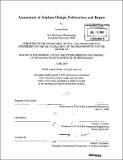| dc.contributor.advisor | Jerome J. Connor. | en_US |
| dc.contributor.author | Stolar, Lauren (Lauren Elise) | en_US |
| dc.contributor.other | Massachusetts Institute of Technology. Dept. of Civil and Environmental Engineering. | en_US |
| dc.date.accessioned | 2010-03-25T14:57:13Z | |
| dc.date.available | 2010-03-25T14:57:13Z | |
| dc.date.copyright | 2009 | en_US |
| dc.date.issued | 2009 | en_US |
| dc.identifier.uri | http://hdl.handle.net/1721.1/53075 | |
| dc.description | Thesis (M. Eng.)--Massachusetts Institute of Technology, Dept. of Civil and Environmental Engineering, 2009. | en_US |
| dc.description | Includes bibliographical references (leaf 43). | en_US |
| dc.description.abstract | Engineering programs are most often classes dedicated to how to design things, while the topic of reverse engineering or problem solving is rarely discussed. This unequal presentation of two sides of the same discipline limits the student's ability to completely understand the engineering process. This paper discusses all stages of airplane design, fabrication, and repair, and attempts to provide a comprehensive view of the overall procedure instead of just one aspect. In most cases, the Boeing 747 is used as an example, though most commercial aircrafts are built in a similar fashion. Once it has been decided to build a new airplane, the design stage can begin. The progression through conceptual design, preliminary design, and detail design can take anywhere from a few to several years depending on the complexity of the model. The fabrication stage slightly overlaps the detail design phase as coordination between engineering and manufacturing occurs. With one exception on the wing panels, the entire airplane is put together manually. This type of build process naturally leads to mistakes by human error. In order to remedy these problems, engineers inside the factory take responsibility for restoring the airplane to its original designed capacity. In this paper, each stage of airplane development from initial concept to final certification is presented in detail to offer a well-rounded assessment of the airplane construction industry. | en_US |
| dc.description.statementofresponsibility | by Lauren Stolar. | en_US |
| dc.format.extent | 44 leaves | en_US |
| dc.language.iso | eng | en_US |
| dc.publisher | Massachusetts Institute of Technology | en_US |
| dc.rights | M.I.T. theses are protected by
copyright. They may be viewed from this source for any purpose, but
reproduction or distribution in any format is prohibited without written
permission. See provided URL for inquiries about permission. | en_US |
| dc.rights.uri | http://dspace.mit.edu/handle/1721.1/7582 | en_US |
| dc.subject | Civil and Environmental Engineering. | en_US |
| dc.title | Assessment of airplane design, fabrication, and repair | en_US |
| dc.type | Thesis | en_US |
| dc.description.degree | M.Eng. | en_US |
| dc.contributor.department | Massachusetts Institute of Technology. Department of Civil and Environmental Engineering | |
| dc.identifier.oclc | 501946432 | en_US |
